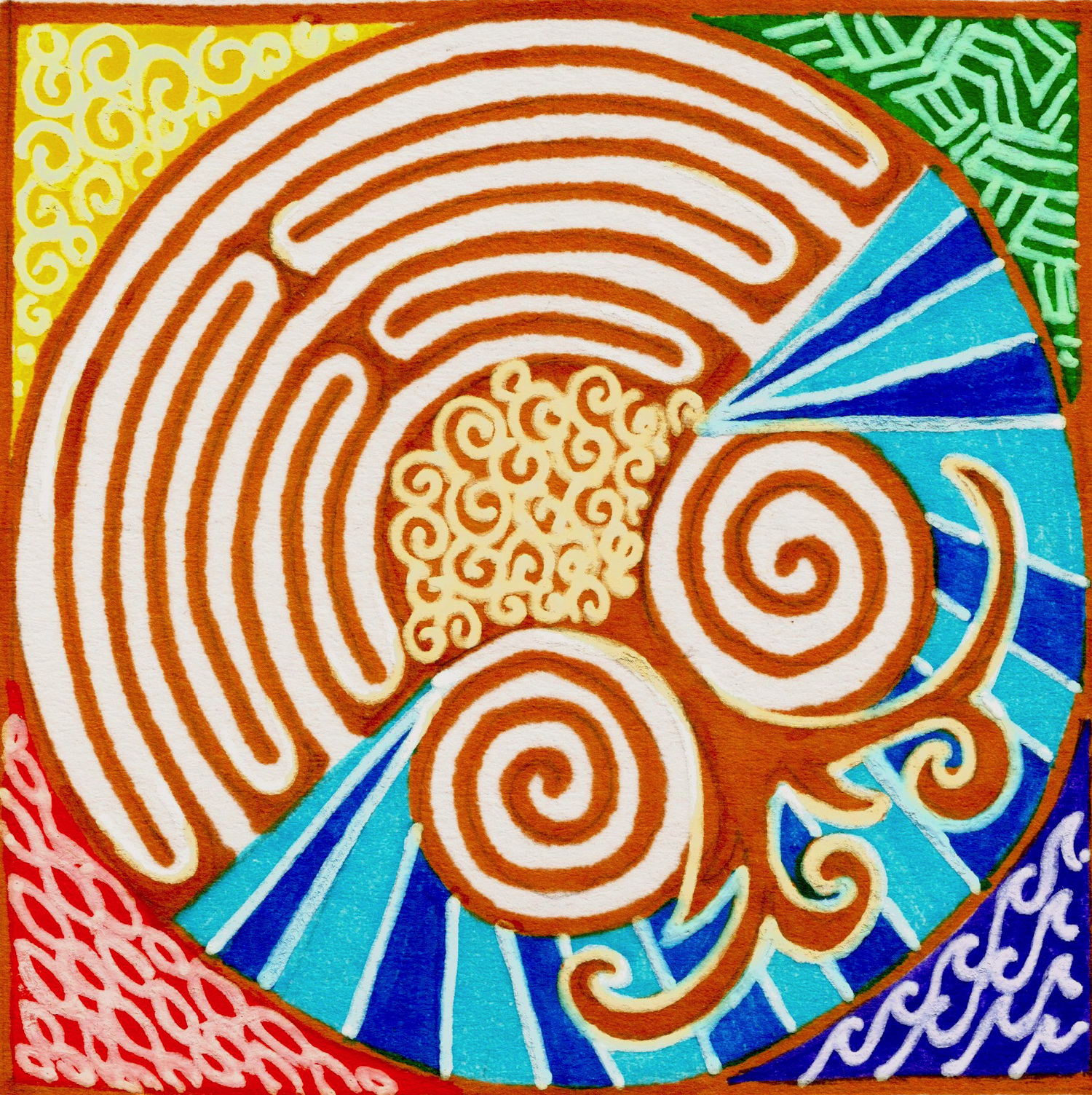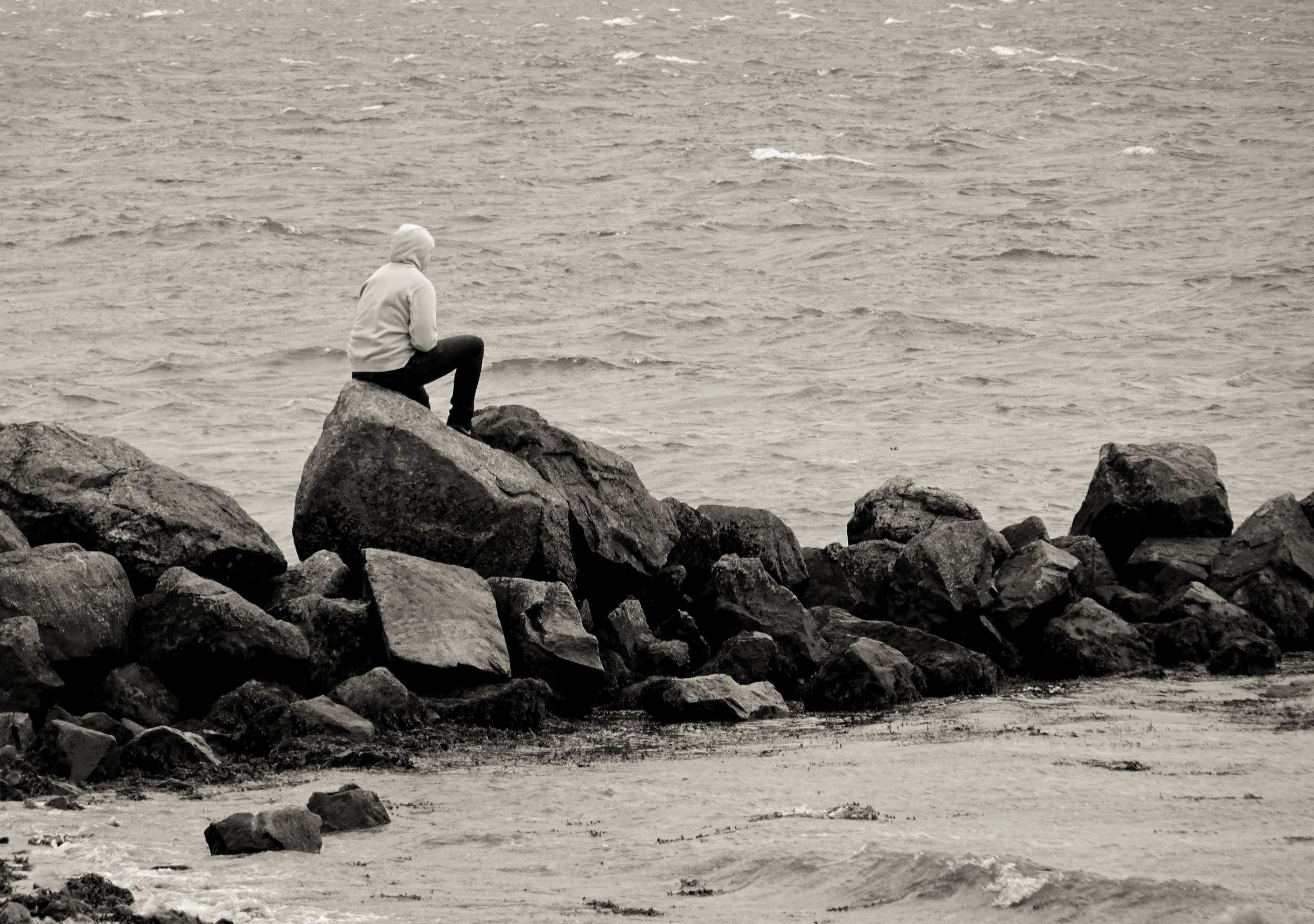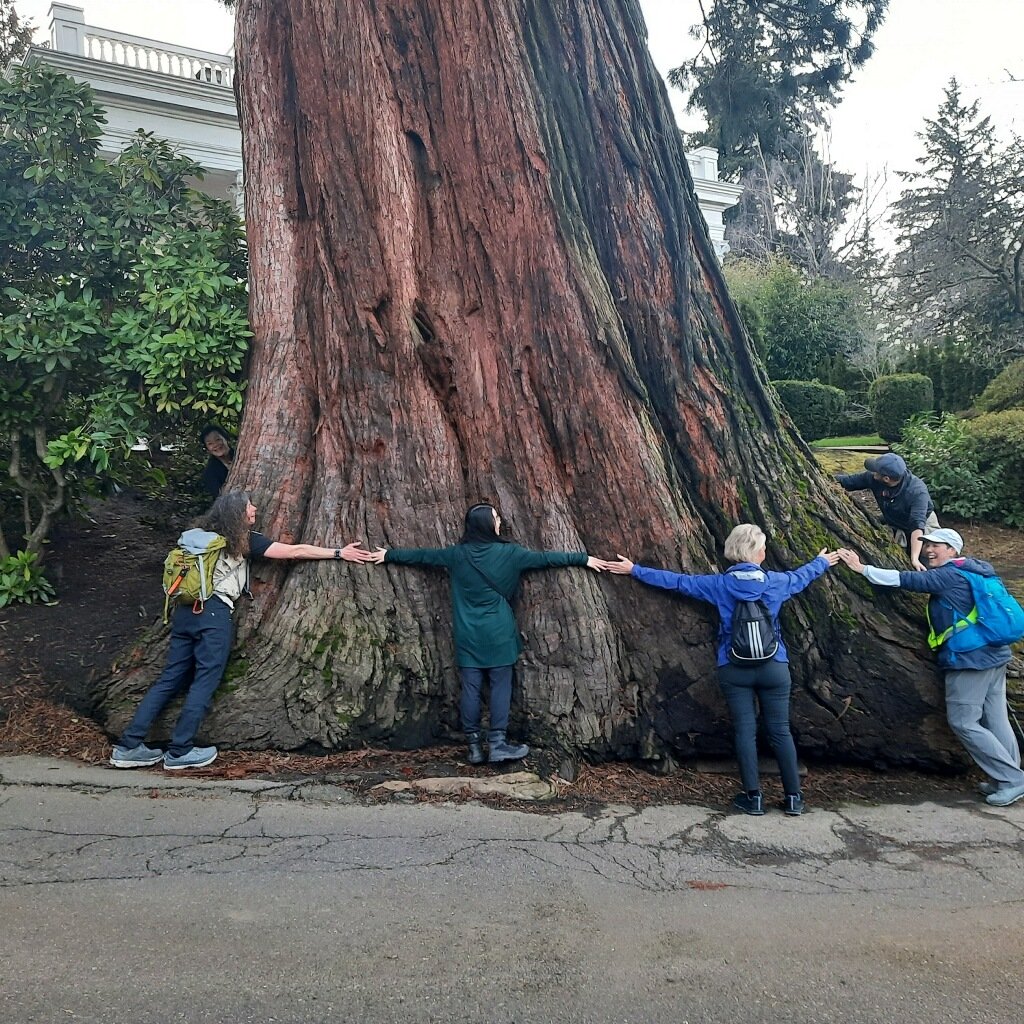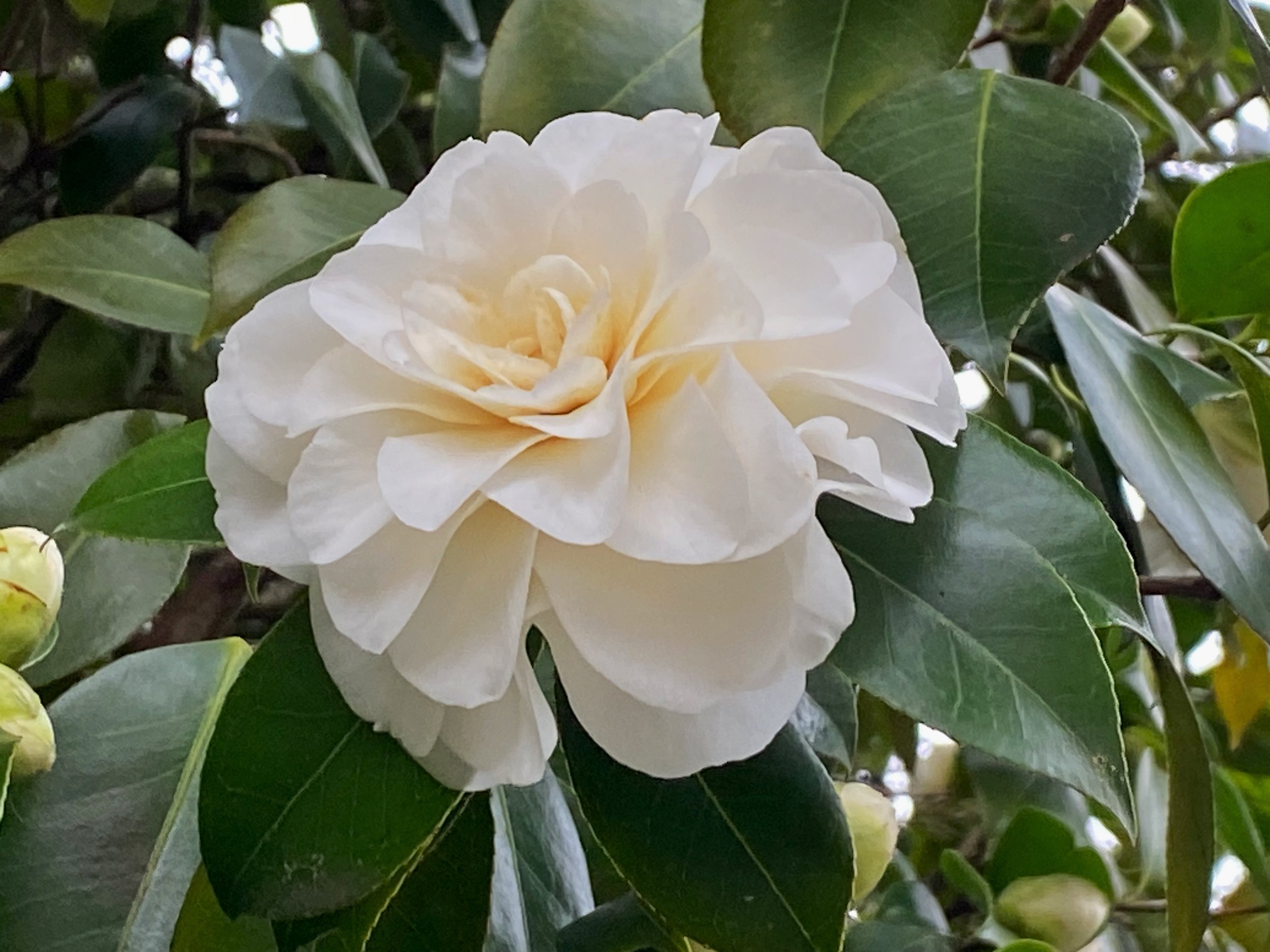Mural in Portland, Oregon that resonated with the theme: We Are all Connected. Muralist Mercedes Tabish. photo by anne richardson
Listening for Undertones & Connection
Spring arrived in the Pacific NW on the appointed day and week in fine fashion with a few 60º days, rapturous robin songs, crocuses popping out of the ground…and then snow? Not a lot. It soon melted, but it startled. Rain predictably returned. But the mornings have hovered just above freezing, the chill of winter not quite ready to take leave. Spring, like me these days, seems to be struggling to settle into a rhythm. Or maybe the struggle is actually the rhythm with a bit of improv thrown in and if I listen closely enough I can hear the undertones.
When I stop and listen closely. When I get out of my own way, I become more connected to the whole. I am part of, not apart from. It allows me to be in streams of life. To flow in and through and mingle in what Bayo Akomolafe intertwines in his essay, When you Meet the Monster, Anoint Its Feet (Emergence Magazine, Oct 16, 2018) the concept of “‘holobionts,’ assemblages of bodies within bodies within bodies, or intersecting communities that toss out notions of separable individuality.” To live as part of this land needs to be done with reciprocity, though honestly, I still feel the land and all the beings I’m engaging, or assembling, with are offering me more. But I give back what I can.
Grief & Loss: A Common Thread
As I started and restarted and restarted this blog again again again, I looked for threads. There is always the Grief and Loss thread. My intentional leaning into teachings on Grief and Loss will always provide something “useful." Lately it has been the colorful thread of resilience. But then I’ll find surprises in unexpected places. A FaceBook or Instagram post. Random article. Email. Podcast. “Non-Grief” books. Conversations. Hmmm. Grief and Loss are universal my mentor, Grief, keeps reminding me.
“Loss needs a new cosmology: not one that treats it as a deficit, something to fill quickly with a replacement. Not as sustainability - the disguised primal cry of the modern self for permanence.
Loss needs a new home. Suitably, one that wanders.”
Gathering the Threads
Does that happen to you? Where are you gathering new teachings? New wisdom? New ideas? You want to pull all your thoughts together into one cogent theme but all you have is a tangled mess? Sigh. So let’s see what unfolds with no guarantees it will make sense, but I do hope you will find something you can take away. Let’s start with the thread of resilience, though at the end I am going to fray the thread with some push back.
A resilient tree, or is it trees now, as it has adapted to the seasons of life and is connected in so many ways to the community it is immersed in. photo by anne richardson
It is possible to live and grieve at the same time.
Dr. Lucy Hone
Resilience & Grief
Resilience is not a new way of coping with loss, but it seems to be more prevalent in my awareness these days. Perhaps I shifted my perspective? Or maybe the pandemic brought resilience into our collective focus…more articles, books, etc. In my Winter newsletter I referenced a 2015 TedTalk by Dr. Lucy Hone that soared in popularity during the early days of the pandemic. Before that it only had a few thousand views. I also viewed her webinar at the recent 3rd Annual Symposium of Death and Bereavement Studies where the symposium topic was "Cultivating Radical Resilience.” Dr. Hone’s book, which I have not had an opportunity to read is: Resilient Grieving: Finding Strength & Embracing Life After a Loss That Changes Everything. Her life changing loss was the death of her 12-year old daughter in a car accident.
Strategies of Resilient People
What she offers in her TedTalk are three strategies she has found in resilient people and “are available to anyone”:
Resilient people get that suffering is part of life, even if they don’t welcome it. They don’t ask “why me?” or assume they are entitled to a perfect life.
Resilient people are good a choosing carefully where they place their attention. Appraising situations and typically manage to focus on things they can change and accept the things they cannot. They do “benefit finding” or “look for the good” in life.
Resilient people ask, “Is what I am doing helping or harming me?” For example she chose not to go to the trial of the man who drove the car that killed her daughter, discerning it would be too hurtful to her. Her husband met with him at a later time. They made different choices.
I appreciated the closing line of her TedTalk: “It is possible to live and grieve at the same time.” She emphasized that resilience doesn’t discount grief and pain.
So Many Grief Nuggets, So Little Time
There were five highly regarded speakers/presentations at the Death and Bereavement Symposium and to recap them all would take up more space than is reasonable in one blog. So over several blogs I’ll share nuggets that I hope you will find helpful to support you or others you come alongside. If you are interested in finding out when the next one is you can sign up for the host’s, Dr. Terri Daniel’s, newsletter (and see what other education and bereavement support she offers). And to find out more about what Dr. Hone and her associates offer go to the New Zealand Institute of Wellbeing and Resilience.
Ambiguous Loss & Resilience
I completed the modules in my class: Ambiguous Loss: Its Meaning and Application (yay!) And wouldn’t you know it, resilience also helps those coping with ambiguous loss according to Pauline Boss’ model. First what is ambiguous loss?
These are the key components:
It is a loss that is unclear.
It has no resolution or closure.
It is an uncanny loss—confusing and incomprehensible.
Is when a loved one’s status as absent or present remains hazy.
The duality of loved ones being absent and present at the same time is confusing and finding meaning (or making sense of the situation) becomes challenging.
It ruptures relationships as they were known.
Something is definitely lost, but unlike a death, no one comes to validate and support the loss.
The usual customs and rituals used to manage grief are not available.
It can’t be fixed.
When in the midst of an ambiguous loss, it can feel isolating. Galway, Ireland. photo by anne richardson
Examples of Ambiguous Loss
Here are some examples: The disappearance of Malaysian Airlines Flight 370, where no bodies have ever been recovered (or any instance where a body is not recovered, including 9/11, wars, kidnappings, runaways.) This is type of loss is where the person is physically gone but psychologically present.
The other type is when the person is physically present but psychologically absent, such as with dementia, addiction, someone who is generally tuned out in a relationship. Also consider immigrant families who have left family behind. Their homeland and those they left behind are often very much present in their minds (and this would be the same for those back home). I think of how this was true for my mother as she awaited the arrival of her weekly air letter from her mother over the years. There was ambiguous loss on both sides of the Atlantic.
Living with Ambiguous Loss
Per Boss’ model, to live with ambiguous loss with resilience one needs to:
Find Meaning: being able to understand the experience by accepting two ideas simultaneously—the relationship is strangely lost, yet still exists (both/and thinking).
Balance Control with Acceptance: understanding what one can control (for example: perceptions, tolerating ambiguity) with what is an irresolvable loss.
Broaden Ones Identity: Acknowledge shifting roles. Asking “Who am I now?” in this relationship and family structure.
Manage Mixed Emotions: All feelings are normal, including conflicted emotions (ex: joy and anger). However, need to talk with someone if at risk of acting out negative emotions.
Hold on and Let Go: Relationship is more one-sided. Attachment needs to be revised. The relationship isn’t broken and it isn’t the same. Accepting what is still available and grieving the connections that are no longer possible.
Imagine New Hopes and Dreams: This arises out of resilience.
Take the Time to Care for Ones Own Health.
(Source: Loving Someone Who Has Dementia, How to Find Hope While Coping with Stress and Grief, Jossey-Bass, 2011, Pauline Boss, PhD.)
Ambiguous Loss: Our Common Thread
Though these terms are from Boss’ book on dementia, they are applicable to any ambiguous loss and are expanded on in her text book, Loss, Trauma, and Resilience. Therapeutic Work with Ambiguous Loss. What Boss emphasizes in her class is that WE ALL HAVE EXPERIENCED SOME KIND OF AMBIGUOUS LOSS IN OUR LIVES. No one person can be fully present to us, or we to another, 100% of the time. I’m guessing if you reflect back over your life, you can name instances you have experienced or are experiencing ambiguous losses.
I found this course expanded my understanding of this little discussed yet prevalent loss in our world. I will be a better spiritual companion and friend from what I learned. Hopefully by reading these few words, you will be curious and more open to the ambiguity of ambiguous loss and make room to be with those experiencing it in their lives. For example those who have any unresolved situations, long-covid, loved ones with dementia, cancer, or other life changing illnesses.
Throwing Mud Into the Resiliency Mix
Dreaming of Mud: Mud has been making an appearance in several of my dreams lately, so I’m curious. What is it like when I walk along mud coated paths? What conversation are the two elements of water and earth having when they create mud? What is co-existing in the water, the earth, myself (those “assemblages”)? What if I just stand in mud? Get stuck in mud (I’ve been feeling stuck in some areas lately)? What is mud on a large scale? I remember the devastating mud flows from Mt. St Helens’ 1980 eruption. And I happened upon an article about slow moving mud flows the other day! How is mud like Grief? Loss? (Bet you knew I was going to get there). Lots to ponder about mud. I appreciate how mud makes me slow down my pace….and I already live a slow life. When I fall on a muddy path, I’m not always appreciative, but there is something in that too. And what does mud have to do with my fraying the thread of resiliency.
Resiliency as the New Fix?
Well, what if we need to slow down the “fix” of resiliency? What if “Resiliency” becomes the new Five Stages of Grief? Yup, those “five stages of grief”? I’d love it if you forgot them. (As an aside: they are NOT valid and there are other well researched Grief Theories to support those who need therapeutic help.) In our society we tend to attach ourselves to an idea and then turn it into cement. Make it a one-size-fits all look. Inflexible. On its face “resiliency” seems like a healthy way forward through Grief and Loss (and it has well-researched theories behind it.) We see resiliency in nature (and I tend to seek out nature for wisdom). See how bacteria are starting to eat contamination in lakes!
But what happens if we decide someone isn’t “resilient” per a set of criteria that gets folded into popular culture? What if resilience becomes the new measure of how someone is “properly grieving.” We are quick to pathologize grief because there is so much discomfort around how folks are grieving. That is one of my concerns. That we will say to someone in the depth of a loss: “Yes you are suffering, but everyone suffers.” Or, “You just need to find the meaning in all this.” Try to push the one grieving along so, as the observer, one can feel more comfortable with someone else’s suffering.
Community Not Individuals
In some of what I’ve read, I also see a lack of connecting with community. Once again we are asking individuals to do “the work” of being resilient. “Do your grief work,” we say, instead of calling on what I’ve heard called the Council of Elders. Those who walk beside us in times of suffering and shadow. These could be from our faith communities. Family. Friends. Nature…remember there are many wise beings among the holobionts. When I need support, being by Mother Ocean or by trees is my comfort as well as my human community. If we are to shift our Western Culture’s way of being with Grief and Loss, we need to step away from individualism and into community and hold each other’s Grief together.
My community of Mazamas Street Ramblers. We support each other and this stunning urban sequoa allowed us to wrap our arms around her. Nine of us all together! Portland Oregon.
Grief is a Natural Response of the Heart
So, yes, resilience can be helpful in navigating Grief. Loss. But does your resilience need to be “radical”? Is it okay to squash through the mud at your own pace? Or just be stuck in the mud for as long as you need, gathering all those “assemblages” in the mud with you? I received Mirabai Starr’s email with this nugget that offers the “and” to any dogma that may arise to counterbalance resilience run amok:
Grief is a natural response of the heart, and there is no right or wrong way to grieve. It is not a linear trajectory and there isn’t a map that will lead you to the other side. There is no other side. Grief is a lifelong adventure of loving and integrating, yearning and honoring, ever more deeply. Nor is there a timeline. Your task is to be exactly where you are, and our task is to bear loving witness to your unique process.
Still, there are certain universal features along the way, and it can be comforting to see yourself reflected in one or another of these thresholds at any given time.”
She is very wise and so much of what she writes aligns with my own thoughts. You can sign up for her musings if you are interested.
Anyway, as you discern how to navigate your Grief, your Losses, consider bringing alongside community that supports you. Ask yourself, “Who are my Counsel of Elders?” human and non-human. Use what has been offered about resilience and see what is helpful for you at various points along your journey. Some days it may be just what you need to, well, get through a day. And other days Grief may want you to be in the mud, being ever so slow and kind to yourself.
And if this all feels rather, well, muddy, being with Grief and Loss isn’t clear. Perhaps the Losses in you, in us, are looking for a “new home and are wandering”. And that is why there is no right way to navigate this journey. No one north star. No one model that will get you and me to a non-existent “other side.” But there is community. There is caring. There is kindness. May you find at least one on any given day.
with deepest gratitude,
anne
Spring calls through the threshold, “i have arrived”. photo by anne richardson
For Your Reflection
what does resilience look like to you? are there times you can recall being resilient? has resilience helped you through difficult times or helped someone you know? i was brought up in a “stiff upper lip” culture which could be seen as a short term way of coping, but i don’t see as resilient in the long term because the loss was never discussed in depth. what about you? what beliefs did you absorb about coping with loss when you were young or in your culture?
who are your “Council of Elders?” who would ask you to be on theirs? is Grief on your council? Joy?
can you name some ambiguous losses in your life, past and/or present? how have they been acknowledged by those around you? as you reflect, have you named them before now as “ambiguous”? how might you give voice to what you are experiencing?
Bayo Akomolafe talks about loss needing a new cosmology, which i hear as a new way of understanding and being with loss. loss needing a new home. what does this mean to you? what might it look like for your personal losses to wander?
Mirabai Starr speaks about Grief being a “lifelong adventure of loving and integrating…” and not “having a timeline.” how might you be with your Grief if you were to consider it a companion and you were on an adventure, though a hard one, together for a lifetime, crossing thresholds….some very muddy.
usual question: are you treating yourself with kindness and gentleness these days? how does that look? if not, how might you make the shift to being kinder and gentler with yourself? how can you be kinder and gentler toward others.
Grief Odds and Ends
The Dougy Center for Grieving Children has so many resources. I encourage you to check out their website. Did you know they host the podcast Grief Out Loud and they recently had their 250th episode (March 16th), which I found it deeply moving and, yes, an example of resilience amid a most difficult loss. I highly recommend listening to Finding The Words - Colin Campbell Besides the tenderness of the story, it offers insights in talking to folks who have experienced one of the most difficult losses, the death of a child.
Talking about Death and Dying can be difficult when you are healthy, let alone have been diagnosed with an life altering illness….or are simply aging. How do you start the conversation when you are not fluent in “death talk”? I recommend The Death Deck. Per the website: “Have Fun With Some Taboo Talk. Play the new party game that lets you explore a topic we’re all obsessed with but often afraid to discuss”. I have found it helpful in jumping into those uneasy conversations with friends that may be less willing. They also have a new deck out, the EOL (End-of-Life) Deck, that “is a tool used by families, caregivers, and healthcare providers to help facilitate conversations about end-of-life wishes. With a casual tone, multiple-choice and open-ended questions, the E•O•L Deck makes starting conversations about what matters most a little easier.” I just purchased this and it looks great.
Coffee and Grief Community hosts Coffee Talk the first Thursday evening of every month (7pm PT on Zoom). Five writers read their heart balm words. I look forward to this every month and highly recommend. To get the links each month follow Coffee and Grief FaceBook or, if you follow Nurture Your Journey on FB, I usually post the link the day before or day of.
April is National Poetry Month!
As you can imagine it is one of my favorite months of the year. Poetry is so accessible these days! I am blessed to live in an area that has exquisite poets everywhere you turn. I learn so much from reading their words. And how about you? Do you remember the first poem read to you? A poem that moved you? Made you laugh? Are you Interested in participating in National Poetry Month?
You can subscribe for a free “poem-a-day”.
You can participate in poem in your pocket day on April 27th (#pocketpoem).
Send me your favorite poem(s).
Check out the Academy of American Poets website for more information.
Speaking of poetry, I’ve been stuck lately and not writing much…but I do have one of my heart poems coming out in Mountain Bluebird Magazine’s spring issue. This is a wonderful small press by the amazing Jenny Forrester. If you feel a nudge, please subscribe.
And poetry circles are one way to help folks reflect on the life journey. Here is a small promotion for an in-service or presentation I can offer: Use of Poetry as a Common Language to Explore Grief and Loss.
End Note
I was introduced to Carolyn Hillyer’s work through the Hagitude program I am participating in this year. I found this YouTube video, Gifts For Your Journey, so soothing. It brought me home to myself. Perhaps it speaks to my Celtic Roots. (it is close to the four year anniversary of my leaving on my first sojourn to my heartland.) Perhaps you’ll take 7 minutes to listen and let it be part of your day’s journey.
Until next time, may you find small moments of wonder and awe in your days.










